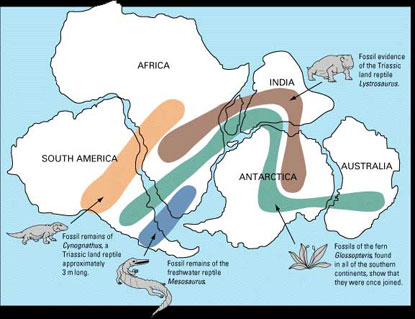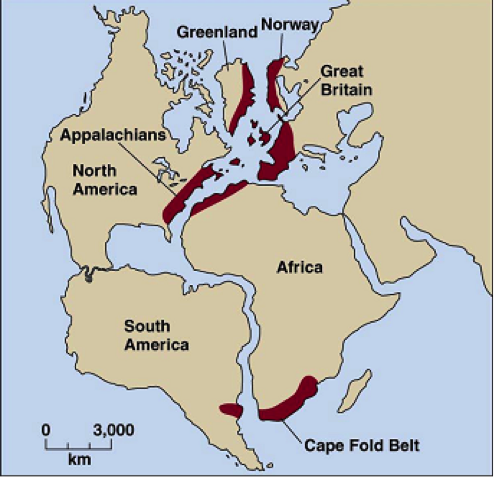Continental drift was Wegener's theory where he explained continents shift position on Earth's surface.
That tehroy also explained why look-alike plants and animal fossils and similar rock formtions found on different continents.
 |
| Pangea (pan=all, gea=Earth in Greek) |
Wegener believed that over 200 million years ago, all the continents were together, joined in one big continent, which he called Pangea, before breaking up and drifting to their current positions.
-Wegener brought together several lines of evidence to support his theory:
Wegener noticed the continents surrounding the Atlantic ocean looked like they could fit together, much like puzzle pieces, not at the continuously changing shoreline, but at the edge to their continental shelves.
-Fossil evidence
Animal and plant fossils found in the western South Africa match nicely with fossils found on the east coast of South America.
Also, he noticed that some of the fossilized life found in the rock record didn't match with the zones they were found in. (Rocks in Alaska contain fossil palm tree leaves)
Wegener also noticed that there was the same wildlife living in differents continent coasts separated by an ocean.
-Rock type and geologic structural similarities
There was an identical pattern of rock on the Appalachian Mountains, the Calendonians and the Scandinavian Mountains.
The continents in the southern hemisphere (Africa and South America) also had a similar kind of rocks in their mountains.
-Paleoclimatic evidence
He noticed that there were trace of cold climates in warm zones.
-Apparent Wandering of the Earth's Polar Regions
By looking at the angle of their magnetic field, paleomagnetim is used for knowing how far were the rocks from the poles when they were formed.
The story told by different continents is usually contradictory, and can only be explained if we assume the continents have moved over time.
-Geodetic evidence that Greenland was moving away from Europe at a measurable rate
With all those evidences Wegener concluded that the continents had to be together once, so that, the fact that different animals, fossils or rocks were found in different continents will make sense.
 Although Wegener's observations and evidences about fossils and rocks were mostly correct, he was wrong thinking that the continents might have plowed through the ocean crust like icebreakers sashing through ice.
Although Wegener's observations and evidences about fossils and rocks were mostly correct, he was wrong thinking that the continents might have plowed through the ocean crust like icebreakers sashing through ice.
Geologist soundly denounced Wegener's theory of continental drift, because they said he didn't have a good model to explain which kind of power have been able to break Pangea and how the continents have moved apart.
Several years later, Wegener's theory resulted to be the key to develop the new theory about the origin of the continents Plate tectonic theory, which was based in Wegener's hypothesis.
Nowadays Alfred Wegener is one of the most important scientists on the history.

